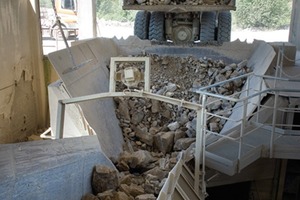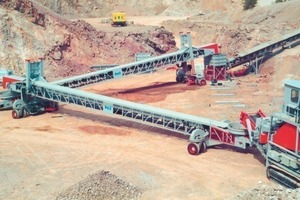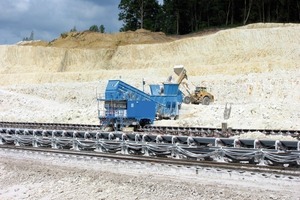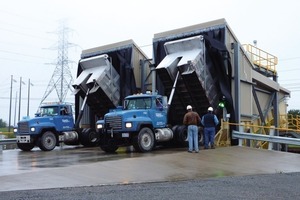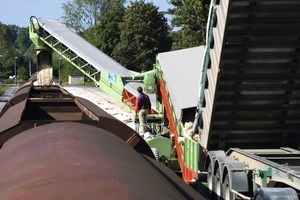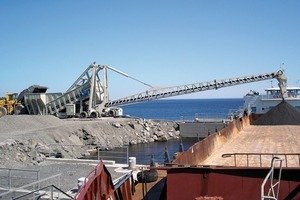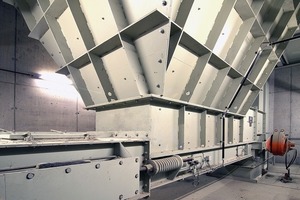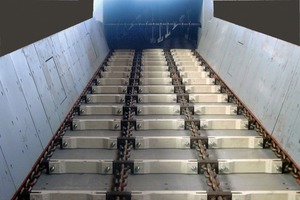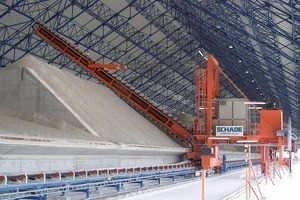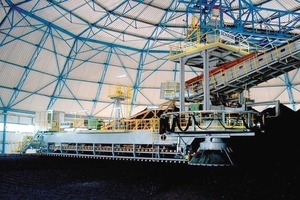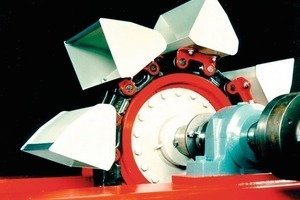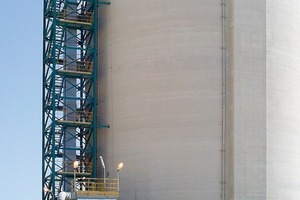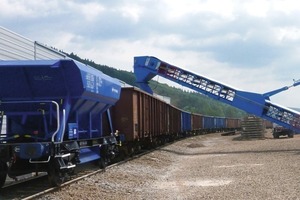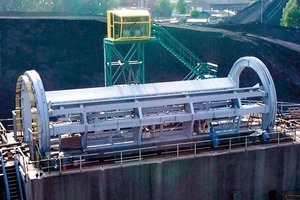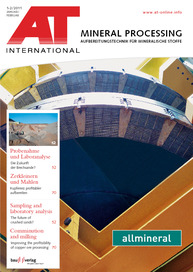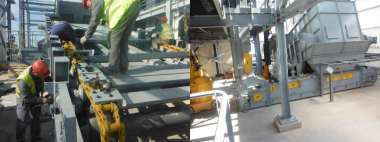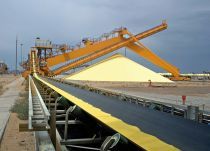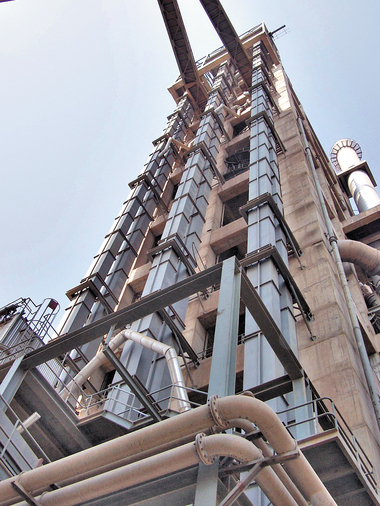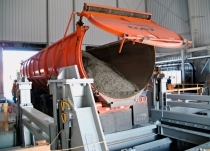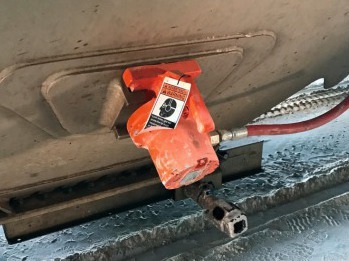Logistics in mining and minerals
Industrial minerals are shipped across the globe in large quantities demanding efficient logistics to both minimise the cost of transportation and the carbon footprint. The Aumund Group have developed a range of bulk handling solutions from the mine site to the processor allowing the operator to take maximum advantage of any combination of truck, rail, barge and deep sea shipment. The Aumund Group offers various solutions to address the handling of minerals from the as-mined ore through to the mill bunkers at the process plant. At the mine site the fundamentals of extracting the raw mineral has not changed in centuries, the rock is blasted from the face and loaded onto trucks to be taken to a central primary crusher and then conveyed to a secondary crushing and screening station to be stockpiled before export.
Illustrated in Fig. 1 an Aumund type BPB-SF plate feeder receives the as-mined rock. The apron feeder provides a controlled feed rate to the primary crusher with typically with an electrical interface to match the feeder to the crusher performance and avoid overfeeding. The Aumund feeder design is based on tracked vehicle type chains with a rupture strength of 2 x 3600 kN (type D9) and supported on close pitch matching rollers plus central skids to absorb impact loads. Each plate is made in two overlapping parts with milled edges ensuring that the plates articulate at the head and tail sprocket and with an effective seal maintained to reduce the risk of spillage between the plates. Available with a total plate thickness of 80 mm and maximum plate width of 3 m, these machines may be matched to the largest haul trucks for handling rates of up to 3000 t/h.
Of course the Blast-Haul-Crush concept with a remote central fixed primary crusher is expensive to operate when the hauling distance is increased. Trucks are expensive to own and even more expensive to operate with a very high carbon footprint. One solution is to bring the crusher to the face, thus eliminating the intermediate handling by haul truck. B&W Mechanical Handling Ltd., part of the Aumund Group since 2002, pioneered the concept of mobile link conveyors used with a track mounted mobile crusher and hydraulic excavator so that all the equipment operating at the face remained mobile and could be moved back for blasting. The first installation of this type is shown in Fig. 2 at the Silverdale Quarry of ARC in the Lake District in England, combining a track mounted mobile jaw crusher and two B&W 30 m long link conveyors feeding the fixed in-pit conveyor installation.
From the link conveyors the sized material may be conveyed on conventional fixed or semi-permanent field conveyor equipment to the secondary crushing and final screening station and stockpile. Whilst the link conveyor solution eliminates all truck haulage, there is no doubt that for short distances the flexibility of haul trucks is attractive for the operator. Illustrated in Fig. 3 a SamsonTM surface feeder from Aumund is integrated into a twin shaft rotary crusher forming a moveable feed point to a moveable overland conveyor system.
In this mode of operation the sizer and feeder combination may be moved easily along the length of the conveyor to bring the feed point as close as possible to the working face, blasting permitted. The working face therefore runs parallel to the field conveyor and when the workable length of the field conveyor is exhausted the complete package may be moved sideways on the lateral sledges towards the face again and the process repeated. With this application for handling limestone, the system is able to achieve a performance rate of up to 800 t/h using only two articulated trucks.
Where the distances allow this, truck haulage is generally the most flexible option and in this situation the SamsonTM surface feeder solution from Aumund is an attractive option for the intake of raw material (Fig. 4). The Samson combines the benefit of a wide apron plate feeder with the cleanliness of a belt system allowing material to be received directly from trucks without the need for deep underground pits or hoppers.
Where the mine and processor are in close proximity and both either rail connected or near to suitable sidings, haulage by rail is by far the better solution being both more economical causing much less pollution with a very low carbon footprint. At the mine site railcars may be simply loaded using a silo and loading chute system mounted to a suitable supporting structure above the rails. However many mine sites are not rail connected although there may be rail sidings close by. In this situation the StormajorTM mobile developed by B&W (Aumund Group) offers a unique solution allowing railcars to be loaded directly from road trucks at an existing rail siding without the need for fixed plant or infrastructure (Fig. 5).
The StormajorTM may also be utilised for loading to barges for distribution on inland waterways (Fig. 6). On Lake Onega/Russia, Gabbro rock is delivered to the lake side from the adjacent mine and loaded to barges of around 5000 DWT for distribution to Moscow and St. Petersburg. The equipment operates on a simple berth using the long cantilevered outloading boom of the StormajorTM to load the barges moored just off shore in deeper water thus avoiding costly dredging and an expensive permanent concrete dock.
The final link in the logistics chain is the intake and storage of the material at the process plant. A typical hopper/feeder combination (Fig. 7), such as an Aumund type PKF armoured chain feeder is employed to provide a controlled discharge rate to the ongoing conveyors. Scraper bars mounted on round link chains (Fig. 8) is a well-established and proven solution with the advantage of being fully enclosed and thus dust tight and spillage free. For underground installation clean operation is essential to minimise housekeeping costs in areas difficult to access.
In addition to the underground feeders and associated conveyors the typical package would include the enclosure building with the option of comprehensive dust collection equipment depending upon the material handled and the sensitivity of the location. From the rail or road intake facility typically the bulk mineral will be conveyed to local storage facility such as a dome or silo system. For larger volumes a horizontal storage system including perhaps blending where material may be supplied from a range of sources may be appropriate. Schade (Aumund Group) offer a range of storage systems based on travelling stackers and chain-scraper type reclaimers for automated operation.
Shown in Fig. 9 is a typical longitudinal storage solution with travelling and luffing boom stacker plus a cantilevered boom style reclaimer recovering dissimilar materials from discrete storage bays. The boom type chain scraper reclaimer concept draws material from the inclined stockpile face and discharges to a collecting conveyor running parallel to the stockpile. For more efficient blending at the storage facility the bridge reclaimer system (Fig. 10) offers true homogenisation producing a reliable and consistent material specification for the process plant. Both boom type and bridge type reclaimers may be supplied in a circular format with the option of light weigh dome enclosure. This is the most economical storage solution both in terms of total capital cost and also plant footprint.
In most process applications at some point in the handling systems material is stored in silos of either concrete or steel construction. To raise the bulk mineral to the storage silo the Aumund type BWZ central chain bucket elevator (Fig. 11) has proven an effective solution with around 2500 installations worldwide. Vertical elevation minimises the plant footprint and is totally enclosed with no risk of dust escape or material spillage. The elevator plus feeder equipment may be integrated into a package for road intake, as shown in Fig. 12, or for rail intake.
The equipment illustrated here for intake from rail is all based on the use of hopper bottom or side door self discharge railcars where the material will fall naturally under gravity to the hopper below. Unfortunately not all countries have a sufficient supply of such railcars and Fig. 13 illustrates a combination of new hopper railcars and the old flat bottom type. Obviously the hopper bottom cars are easy to discharge but conventionally the flat bottom cars will need manual excavation, a time-consuming and expensive process that slows the operation considerably. Illustrated in Fig. 14 the Aumund railcar tippler installed in a Polish port handles exactly this type of flat bottom railcar by clamping the railcar in the tippler frame and rotating it to discharge the contents to a hopper and feeder below.
AUMUND Group, Rheinberg (D),
Tel.: +49 2843 72-0, www.aumund.com

